
In Brahma samhita, Lord Brahma praises Krishna as ‘Govindam Adi Purusham’, who is widely recognized by spiritualists in India and around the world as the Supreme Lord (Isvara Parama Krishna). Krishna is also considered as the original and oldest personality, without any superior (anadir adir Govinda), and the ultimate cause of all causes (sarva karana karanam). Lord Shiva, who is responsible for the destruction of the world, is regarded as Krishna’s great devotee (vaishnavanam yatha shambhu) and even holds the water of the Ganges that washed Krishna’s lotus feet on his head as a sign of respect. In the Bhagavad Gita, Krishna reveals that he is seated in everyone’s heart as the Paramatma (supersoul) and that remembrance, knowledge, and forgetfulness originate from him (Mattah smritir jnanam apohanam ca). He also controls the material nature (prakriti) that governs the living entities of this world (Mayadhyaksena prakrtih suyate sa caracaram). Maha Vishnu, who lies in the causal ocean, and from whose body pores the countless material universes emanate, is a partial expansion of Lord Krishna. This article will cover some of the most prominent Krishna temples in India.
#1 Jagannath Temple of Puri
The Jagannath Puri temple, located in Eastern India, is regarded as one of India’s foremost spiritual destinations. Sri Krishna is worshiped in the form of His deity (Lord Jagannath) in this temple, and visiting it is believed to have the same spiritual merit as visiting all other holy sites. The temple boasts impressive Oriya architecture with elaborate carvings adorning each of the four gates. The Mahaprasad served at the temple is a delectable treat that visitors should not pass up. The town’s lively religious festivals attract numerous tourists, with the Rath Yatra being the most highly anticipated. The temple’s spiritual significance, its mouth-watering cuisine, its peaceful ambiance, and the devotees’ passionate devotion make it a must-visit destination.
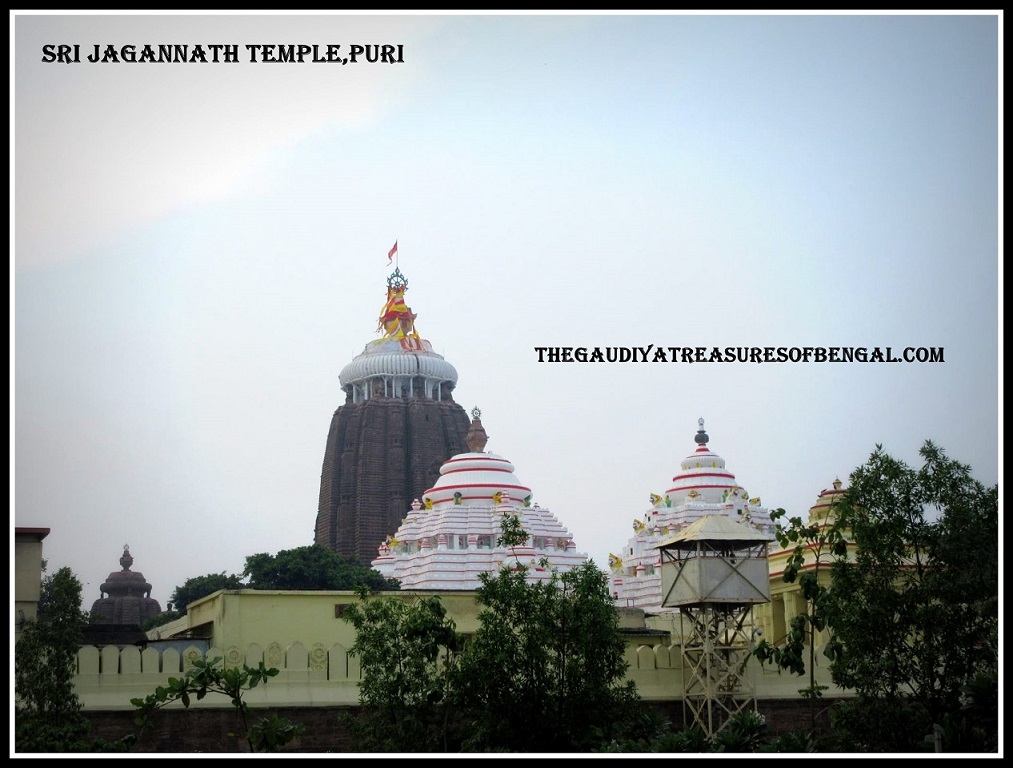
The history of the temple dates back to the time of Satya Yuga when King Indradyumna, a devout follower of Vishnu, consulted his priest for information on a sacred place where he could witness the Supreme Lord. The priest gathered a group of pilgrims who suggested Sri Purusottama Kshetra in Orissa, a location that boasted a temple dedicated to Lord Vishnu. The king dispatched his brother, Vidyapati, to obtain more information, who eventually found the site and described the ornate temple to the king. Narada Muni instructed King Indradyumna to construct a temple and install the deity of Lord Narasimha Deva along with deities of Bhu-devi and Lakshmidevi. The king performed one thousand Asvamedha yajnas and meditated upon the Supreme Lord, which led him to discover a divine tree from which the deities of Jagannath, Baladeva, and Subhadra would be carved.
#2 Sakshi Gopal temple, Jagannath Puri
The Sakshi gopal Temple, situated in the town of Sakshi gopal in Orissa, is a medieval temple dedicated to Lord Krishna. It features a Kalinga architectural style and is well-known in the region. The story of Sakshi Gopal is about two brahmanas who went on a pilgrimage and visited the temple of Sakshi gopal in Vrindavan. One of the brahmanas, who was elderly, promised the young brahmana to give him his daughter in marriage after being impressed by his service. However, the family and relatives of the elderly brahmana were against the marriage and threatened to cut off ties with him if he went ahead with the promise. The elderly brahmana was worried and prayed to Gopal for a solution.
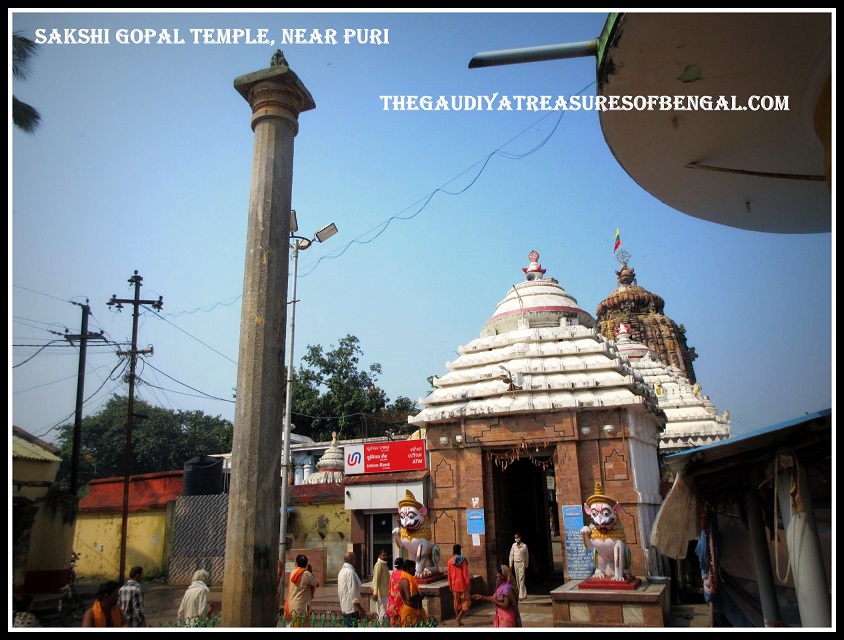
The young brahmana reminded the elderly brahmana of his promise, but the family members chased him away with sticks. The young brahmana then went to Vrindavan and asked Gopal to come with him and be a witness to his case. Gopal initially refused but eventually agreed to accompany him on the condition that the brahmana should not turn his back and notice the deity following him. The brahmana was also asked to cook one Kilo of rice daily and offer it to the deity.
The brahmana walked back to his village with Gopal following him, and the deity became stationary when the brahmana turned around to look. The family members and villagers were amazed to see the deity and asked for forgiveness for not believing the young brahmana. The elderly brahmana’s daughter was then married to the young brahmana with everyone’s approval.
#3 Iskcon Mayapur temple, West Bengal
The holy abode of Mayapur, located in West Bengal, India, is considered by the esoteric to be the very center of the spiritual world and the highest realm of transcendence. Those who are well-versed with the conclusions of the revealed scriptures hold this belief. Mayapur is the birthplace of Lord Chaitanya Mahaprabhu, who is widely believed to be an incarnation of Lord Krishna. He appeared in the world in 1486 AD and began manifesting His ecstatic pastimes, enchanting one and all with His unique movements and unparalleled expressions. He propagated the widespread chanting of ‘Hare Krishna Hare Krishna Krishna Krishna Hare Hare, Hare Rama Hare Rama Rama Rama Hare Hare’.
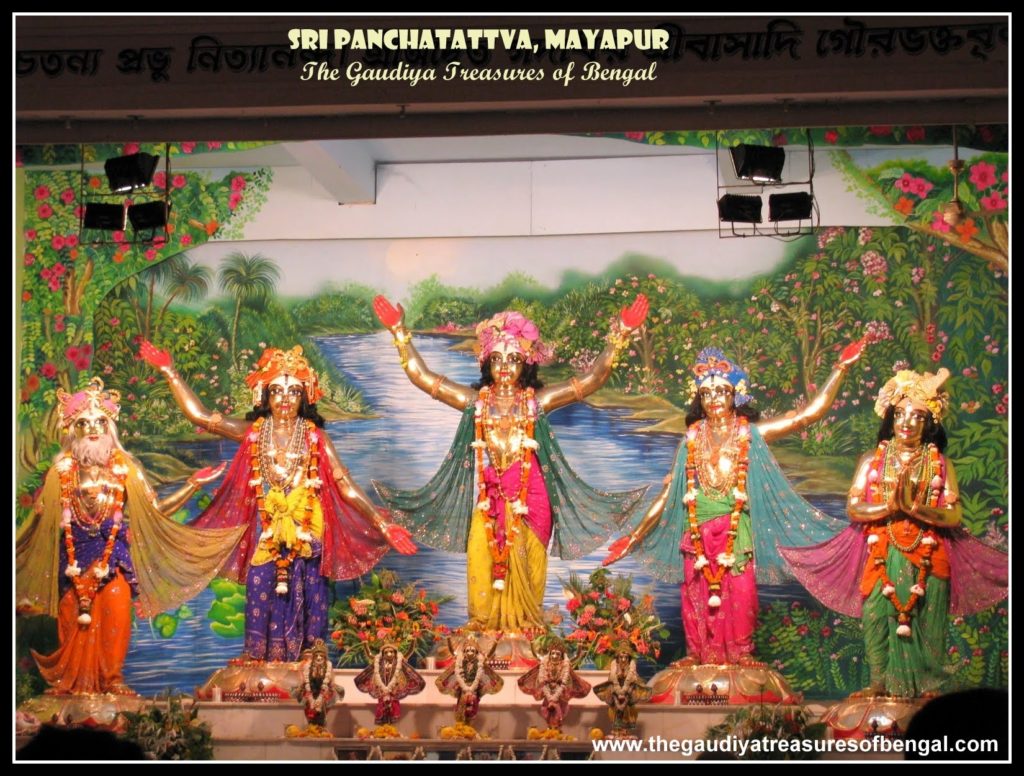
Srila Prabhupada, the founder acharya of ISKCON, named the headquarters of operations as ‘Sri Mayapur Chandrodaya Temple.’ He envisioned this temple to unleash a new age of awakening whereby the misguided souls of this dark iron age could get a second chance to reconnect with their eternal master, Sri Chaitanya. The Sri Mayapur Chandrodaya Temple project, which began in 1971, consists of a gigantic temple in its center surrounded by separate residential quarters. Srila Prabhupada visualized that this project would gradually grow to a population of fifty thousand in the days to come.
What to Experience at Iskcon Mayapur :
- Behold the captivating deities of Radha Krishna and the asta sakhis (8 Gopis).
- Witness the enchanting deities of Pancha Tattva, including Lord Chaitanya and His associates.
- Experience the profound sight of Lord Narasimhadeva.
- Attend the joyful mangala Aratika darsana of the Lord at 4.30 am; it’s not to be missed!
- Pay respects at the samadhi of Srila Prabhupada and his disciples.
- Visit the goshala, where cows are cared for and worshiped.
- Marvel at the Temple of Vedic Planetarium, which is currently under construction.
- Don’t forget to treat yourself to the mouth-watering Krishna Prasadam.
- Yogpeeth, the birthplace of Chaitanya Mahaprabhu, is just a few meters away from Iskcon Mayapur. You can visit there to seek blessings.
- Take home a small book from one of the book stalls to help you further your Krishna consciousness.
#4 Radha Shyamsundar Temple, Khardah, West Bengal
The Radha Shyamsundar temple is located just a few minutes’ ride away from the Khardah train station in West Bengal. According to the Prema Vilasa, Sri Birchandra Prabhu, son of Lord Nityananda, was instructed during his trance to install Sri Syamasundara jiu in Khardaha. To do so, he needed to obtain a saligrama sila from the Nawab’s palace in Murshidabad. Despite the Nawab’s initial welcome, he had sinister intentions and attempted to break Birchandra’s vows by feeding him meat. However, Birchandra’s spiritual potency caused the food to transform into flowers repeatedly, causing the Nawab to realize Birchandra’s greatness and beg for forgiveness.

Birchandra Prabhu then requested to take a large stone above the Nawab’s front gate to carve a deity of Sri Syamasundara jiu, which the Nawab consented to. Birchandra Prabhu then floated the stone down the Ganges river to Khardaha, where he received orders from his father, Nityananda Prabhu, to install the saligrama sila in the form of Sri Syamasundara jiu. The stone had a dark history as it was the same one on which Kamsa had murdered Devaki’s six children over 5000 years ago.
Birchandra engaged a sculptor to carve the deity from the saligrama sila, but the first two attempts did not match the form he had seen in his meditation. Those deities were sent to Serampore and Saibon, where they are now worshiped as Sri Radhavallabh jiu and Sri Radha Nandadulal jiu.
After the first two deities didn’t match the form of Sri Syamasundara jiu as witnessed by Sri Birchandra in His meditation, the third deity manifested from the saligrama sila and was an exact match. Upon seeing this captivating deity, the people of Khardaha forgot their distress and Sri Birchandra proceeded to install and worship it. He organized a grand festival to install the deity, inviting many devotees and serving them sumptuous meals. The merciful Acyutananda, son of Advaita Acharya, performed the abhiseka of Sri Radha Syamsundara jiu.
This temple hosts all prominent Gaudiya Vaishnava festivals with great grandeur, and on the full moon night of the month of Magh, thousands of devotees gather here to commemorate the installation of these deities.
#5 Krishna Janmbhoomi (Janmasthan) Temple, Mathura
The Krishna Janmbhoomi temple in Mathura is an important pilgrimage site, built around the prison cell where Lord Krishna was born 5,000 years ago. The temple has been demolished and rebuilt several times over the centuries, with the present group of temples being the result of a major renovation project in the 20th century. The temple compound comprises the impressive Keshava Deva temple with the ‘garbha griha’ (sanctum sanctorum) and the Bhagavata Bhavan, which houses five shrines, including the main shrine of Sri Radha and Krishna, and an Ayurveda Bhavan, an international guest house, shops, a library, and an open space for performance.
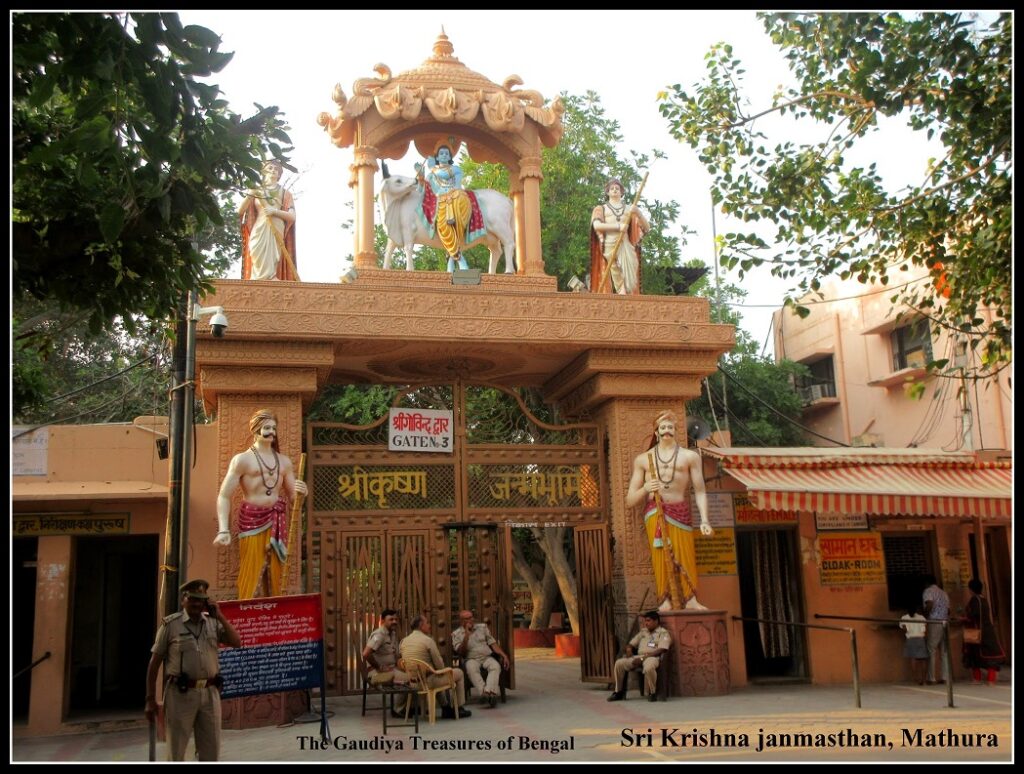
Sri Keshava Deva temple was built in memory of Jadiadeva Dalmia by Ramakrishna Dalmia and was inaugurated in 1958. The ‘garbha griha’ has the appearance of a prison cell, and a marble pavilion and an underground prison cell were built on the site, where Lord Krishna was accepted to have been born. The temple also has a large, deep water tank known as Potra Kunda, where Krishna’s baby clothes were washed by Devaki, which is believed to cleanse one of sins. The Skanda Purana says that one who, while chanting Japa and fasting, reaches the birthplace of Krishna is absolved from all their sins, while the Padma Purana says that those who once enter Krishna’s birthplace during the month of Kartik are successful in attaining supreme, indestructible Krishna.
#6 Madan Mohan temple, Vrindavan
In 1580, Sri Radha Madan Mohan Temple was constructed on a 50 foot hill called Dvadasaditya Tila, near the Yamuna River in Vrindavan, which then used to be a forest. This was the first temple built in the area and was commissioned by Ram Das Kapur on the instruction of Sanatana Goswami. Madanmohan, meaning “one who can even enchant Cupid,” is the deity worshiped in the temple, along with Radharani and Lalita Sakhi. The deity of Madan Mohan was lost for many years until Advaita Acarya discovered the original deity in Mahavan Gokul and served him at the base of an old banyan tree (Advaita vat). Later, Chaitanya Mahaprabhu sent Sanatana Goswami to Vrindavan to find lost places of Krishna’s pastimes and write books about devotional service.
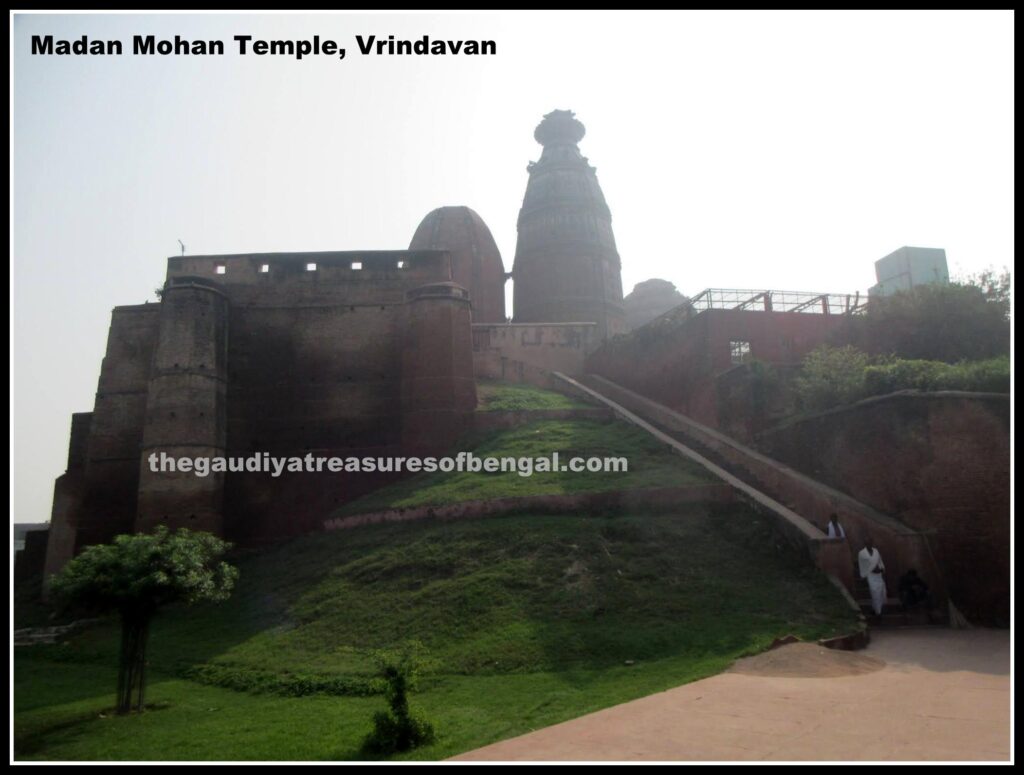
Advaita Acarya used to perform his bhajana at Advaita vat at the base of the hill. Sanatana used to beg in nearby Mathura and one day, came to the doors of a brahmana named Chaube. He saw the Brahman’s children playing with the deity as if Madan Mohan was one of them. Sanatana corrected Chaube for his improper deity worship and taught him the correct ways, but that night, Madan Mohan appeared to Sanatana and Chaube in a dream and expressed his desire to be treated as one of Chaube’s children, and not adhering to such strict rules and regulations. Madan Mohan instructed Chaube to give him to Sanatan, and the next morning, the deity went with Sanatan, promising to be satisfied with whatever he was offered.
Sanatana used to beg door to door and could only offer the deity dry bread balls. When Madan Mohan asked him if he could add salt to the offering, Sanatana declined as he could not afford such a “luxury” being dedicated to his writing. Later, when a merchant’s boat ran aground in the Yamuna river near the Dvadasaditya Hill, Madan Mohan took the form of a small cowherd boy and led the worried owner, Ramdas Kapur, to Sanatana. Sanatana could not do anything about the situation, but he advised the merchant to pray to the Madan Mohan Deity, which he had humbly roofed. Following Sanatana’s advice, the merchant prayed to Madan Mohan, and the rising waters of Yamuna river released his boat. The merchant sailed down to Agra and made a huge profit, and under Sanatana’s direction, he started to build a temple for Madan Mohan in Vrindavan. The temple became one of the symbols and dominant features of the area, and Madan Mohan is still worshiped there along with Radharani and Lalita. In 1670, the original Madan Mohan Deity was moved from Vrindavan to Jaipur when the Mughal Emperor Aurangzeb’s soldiers attacked the area, and it is now located in Karoli, southeast of Jaipur in Rajasthan.
#7 Prem Mandir, Vrindavan
The magnificent Prem Mandir, created by Sri Kripaluji Maharaj in 2001, exudes a sense of elegance and grandeur. Often referred to as the “Temple of Love,” it is a vast religious sanctuary devoted to Radha Krishna and Sita Ram. Situated in Vrindavan, the temple is infused with an atmosphere of sanctity and peacefulness. This newly erected temple is an edifice, and it is thronged by devotees throughout the year.

Built from white marble and adorned with intricately detailed carvings, this temple is renowned for its architectural magnificence. The main temple is bedecked with sculptures of Sri Krishna and his followers, depicting essential events from the Lord’s life. The periphery of the Prem Mandir showcases various scenes from Krishna’s life, such as the lifting of the Govardhan Mountain. The temple’s lighting further enhances its breathtaking appearance, particularly at night. The tinted water flows and dances to the sounds of the Radha Krishna kirtans being performed nearby, creating a captivating audio-visual experience.
#8 Barsana Radharani Mandir
The Radha Rani Mandir, also known as the Sriji temple or Ladli Mahal, is situated on top of a hill in Barsana, a village located 41 kilometers northwest of Mathura. Barsana is famous for being the place where Radha and Krishna manifested their eternal pastimes. The temple houses captivating deities of Radha and Krishna and is considered a significant holy site of Vraja Mandala. The hill on which the temple is built is called Brahmagiri, and it is said to be a manifestation of Lord Brahma, who had performed severe austerities to witness the pastimes of Radha and Krishna. The temple itself is characterized by tall walls, arches, pillars, and red sandstones and is embellished with intricate hand carvings, domes, balconies, and exquisite paintings of Radha Krishna’s pastimes on its inner walls and ceilings.

The present temple is said to have been built by King Veer Singh in 1675 AD, and one needs to climb a flight of about 200 stairs to reach the entrance of the main temple. The deities of Radha and Krishna are said to have been originally established at Barsana 5000 years ago by King Vajranabh, the great-grandson of Lord Krishna, but were lost in course of time. They were later recovered by Narayana Bhatta Goswami, a devotee in the line of Gadadhara Pandita, who had discovered several lost sites of Vraja Mandala and even established the standard path of Vraja Mandala parikrama as had been walked by Chaitanya Mahaprabhu.
Barsana Radha Rani Mandir is a significant pilgrimage site for devotees of Radha and Krishna and attracts thousands of visitors every year. The temple is not only a testimony to the rich cultural heritage of India but also serves as a reminder of the eternal love between Radha and Krishna, which continues to inspire devotees to this day.
#9 Radha Govinda dev temple, Jaipur
The temple of Sri Govindaji has a rich and fascinating history that spans over five thousand years. According to legend, the temple was originally established by Lord Krishna’s great-grandson, Vajranaba. The Deity of Govindaji was one of several important Deities that were installed by Vajranaba in Vrindavan. However, over time, the temple and the Deity were lost to history.
In the 16th century, Srila Rupa Goswami was instructed by Sri Caitanya Mahaprabhu to excavate all of the lost holy places of Vrindavan, including the temple of Govindaji. Rupa Goswami searched tirelessly for the lost temple, but to no avail. Feeling despondent, he sat by the bank of the Yamuna river and began to call out the name of Lord Chaitanya.
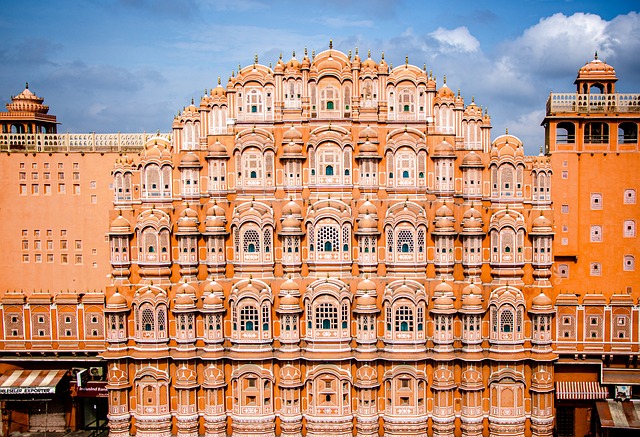
Suddenly, Lord Krishna appeared in the form of a beautiful Vrajavasi boy and led Rupa Goswami to a nearby hill where a cow emptied its milk into a hole on the hilltop. Rupa Goswami fell unconscious upon seeing the Deity of Govindaji within the hole. The temple of Radha Govinda was constructed under the guidance of Raghunatha Bhatta Gosvami and his disciples headed by Raja Man Singh of Jaipur in the late 16th century.
The temple was originally located in Vrindavan and was later moved to Amber, near Jaipur, by Maharaja Jai Singh II to protect the Deity from destruction at the hands of the Mughal emperor Aurangzeb. The temple was eventually moved to its present location in Jaipur in 1728.
Maharaja Jai Singh II created the city of Jaipur as a dedication to Lord Govindaji, and the temple is located within the innermost walls of the old city, right next to the city palace. The temple is set in a garden within the palace complex, and the full-sized Deities of Govindaji and Radha Rani can be found on the altar.
The temple of Sri Govindaji is not just a place of worship but also a symbol of the rich and vibrant history of India. Its intricate architecture, stunning artwork, and fascinating legends attract thousands of visitors every year, making it a must-see destination for anyone interested in the culture and history of India.
#10 ShriNathji Temple, Nathdwara, Rajasthan
Nestled on the banks of the Banas River in Nathdwara town of Rajasthan, lies the sacred Shrinathji Temple, dedicated to Lord Krishna. With a distance of 26 km from Eklingji and 48 km from Udaipur, this temple is a revered pilgrimage site for the Vaishnava community. The name ‘Nathdwara’ signifies the ‘gate of the lord’, and the temple’s construction dates back to 1672 AD, when Goswami priests built it.
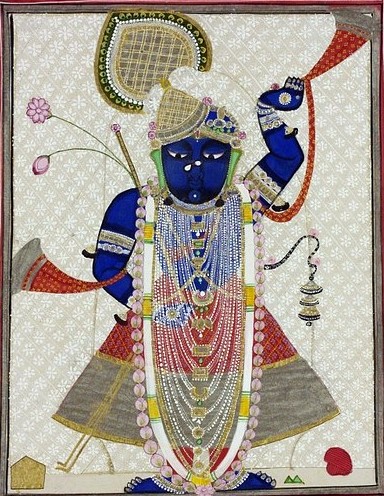
Shrinathji, a deity dedicated to Lord Krishna and originally known as Gopal, was installed by Lord Krishna’s great-grandson, Vajranabha, 5,000 years ago. Later, it was worshiped by Madhavendra Puri in Vrindavan until Rana Raj Singh of Mewar brought Shrinathji to Nathdwara. The story of how Gopalji was discovered is described in the Chaitanya Charitamrita. Madhavendra Puri discovered the hidden deity with the help of a local cowherd boy after having a dream that instructed him to do so. The deity of Gopalaji stands with His left arm raised in the air, recalling the moment Krishna lifted Govardhan Hill to protect the local residents from the demigod Indra’s fierce rains. The worship of Lord Gopalaji at Jatipura was taken over by Srila Vallabhacarya after Madhavendra Puri’s disappearance from this world, and during this time, Gopalaji started being called Shrinathji by the devotees.
As per the legend, during the late 17th century, the idol of Lord Krishna was being transported from Vrindavan to protect it from the wrath of Aurangzeb. While en route, the wheels of the bullock cart carrying the idol got stuck in the mud, and the cart could not be moved any farther. The accompanying priests realized that the particular spot was the Lord’s chosen one, and thus, a temple was built under the rule and protection of the then Maharana Raj Singh of Mewar.
The Shrinathji Temple attracts a multitude of visitors, especially during the festivals of Holi, Diwali, and Janmashtmi. Devotees come from far and wide to catch a glimpse of the exquisite idol of Lord Krishna and offer their prayers to him. The aura of spirituality that engulfs the temple premises is simply awe-inspiring and leaves an indelible impression on the visitors’ minds.
#11 Dwarkadhish temple, Gujarat
The Dwarkadhish temple, also known as Jagat Mandir, is a holy site for Lord Krishna’s devotees located in Dwarka city, Gujarat. Dwarka, situated on the western tip of the Kathiawar Peninsula, is considered one of the holiest sites in India and is part of the Char Dhams pilgrimage, which includes Badrinath, Puri, and Rameshwaram. The temple was destroyed by Mahmud Begada in 1472 and rebuilt in the 15th-16th century. The temple has two entrances, Swarg Dwar and Moksha Dwar. The temple stands on the banks of the Gomti River, is five stories high, supported by 72 pillars, and has two entrances. To reach Swarg Dwar, one must climb 56 steps. Dwarka was the capital city of Lord Krishna, who was the prince of Dwarka and is worshiped here with great opulence. The black stone idol of Lord Krishna is located inside the temple, dressed ornately and adorned with symbols in his four silver-covered hands. During worship, Brahmanas beat drums and blow conch shells. Many small shrines are located within the sixteenth-century Dwarkadhish temple compound, including those of Lakshmi, Shiva, Radhika, Balarama, Pradyumna, Aniruddha, Jambavati, Satyabhama, and Purusottama Visnu. Facing the Dwarkadhish temple is the shrine of Devaki, Lord Krishna’s mother.
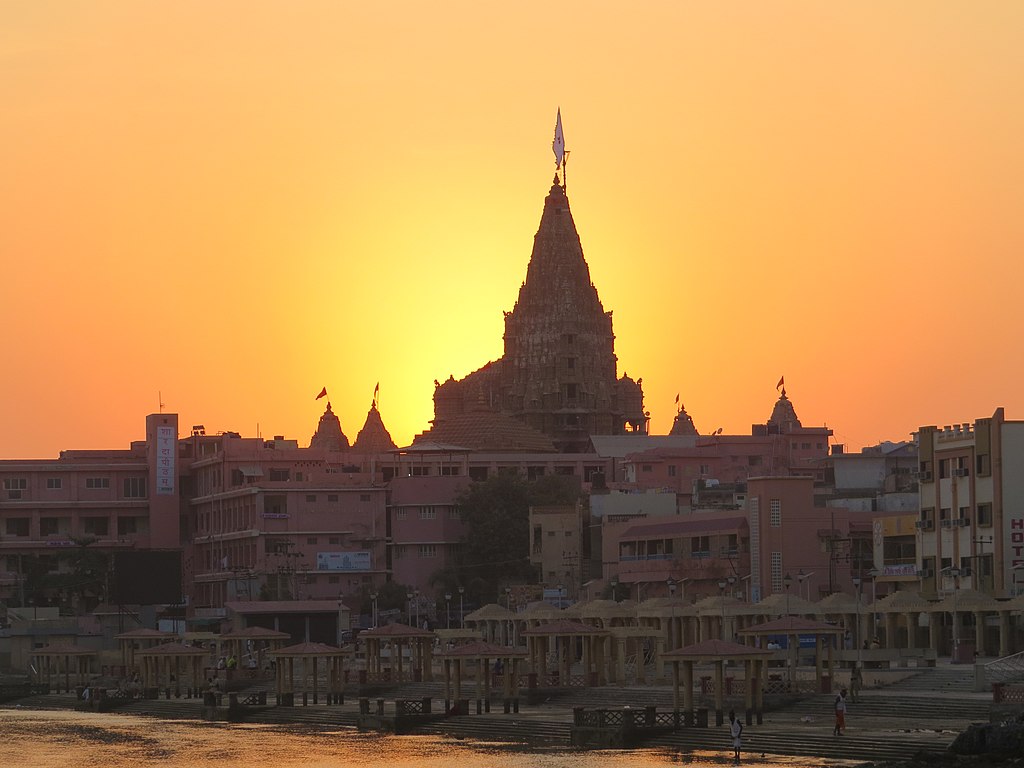
The Dwarkadhish temple is the main attraction for tourists visiting Dwarka and is believed to have been established more than 2,500 years ago by Lord Krishna’s great-grandson, Vajranabh. The temple has undergone several renovations, with imprints from the 16th and 19th centuries. The temple’s heavily sculptured walls are adorned with legends, and its impressive spire stands at 43 meters high. The temple has two doors for entry and exit, and a bridge called Sudama Setu leads to the beach across the Gomti Creek.
The Bhagavata Purana provides a description of the city of Dwarka during the time that Krishna resided there –
The city of Dwarka was filled with the sounds of birds and bees flying around parks and pleasure gardens, while its lakes were crowded with blooming lotuses and the calls of swans and cranes. The city boasted 900,000 royal palaces made of crystal and silver and decorated with huge emeralds and gold and jewels inside. The traffic flowed smoothly on a well-laid-out system of boulevards, roads, intersections, and marketplaces. Many assembly houses and temples of demigods graced the city. The residential area of Lord Hari, gorgeously decorated by the sixteen thousand palaces of Lord Krishna’s queens, was a beautiful private quarter worshiped by the planetary rulers. Narada Muni entered one of these immense palaces with coral pillars decoratively inlaid with vaidurya gems, sapphire walls, and perpetual brilliance floors. The palace was adorned with canopies, seats, and beds fashioned of ivory and precious jewels. Well-dressed maidservants bearing lockets on their necks and armor-clad guards with jeweled earrings attended to the palace. Numerous jewel-studded lamps dispelled all darkness, and peacocks danced on the ornate ridges of the roof. The fragrant aguru incense escaping through the holes of the latticed windows mistook for a cloud.
#12 Udupi Sri Krishna Matha, Udupi, Karnataka
Udupi, located 60 kilometers north of Mangalore, is renowned as the holy pilgrimage site in southern India where Lord Krishna is worshiped. Sri Krishna Matha, the holy shrine, is located in Udupi and is also the birthplace of Sri Madhwacharya, who is one of the great Vaishnava Acharyas and the founder of Dvaita Philosophy. Legend has it that Madhwacharya discovered the idol of Lord Krishna from a ship that he miraculously saved from a fatal storm brewing on the sea at Malpe. Madhwacharya composed five chapters of prayers dedicated to Lord Krishna while heading to bathe in the sea, and during this time, he found a stranded ship on the shore. He gestured to move the ship, and to everyone’s amazement, the ship started moving across the surface of the water. The ship’s crew then offered a piece of Gopi-Candana from Gopi-sarovara in Dwarka as a token of gratitude, which Madhwacharya accepted. However, while returning with the block of Gopi-Candana, it broke, and an enchanting deity of Bala-Krishna was discovered within it at a place called Badabhandesvara. After discovering the deity, Madhvacharya immediately composed the remaining seven chapters of his famous Dvadasa Stotra prayers.
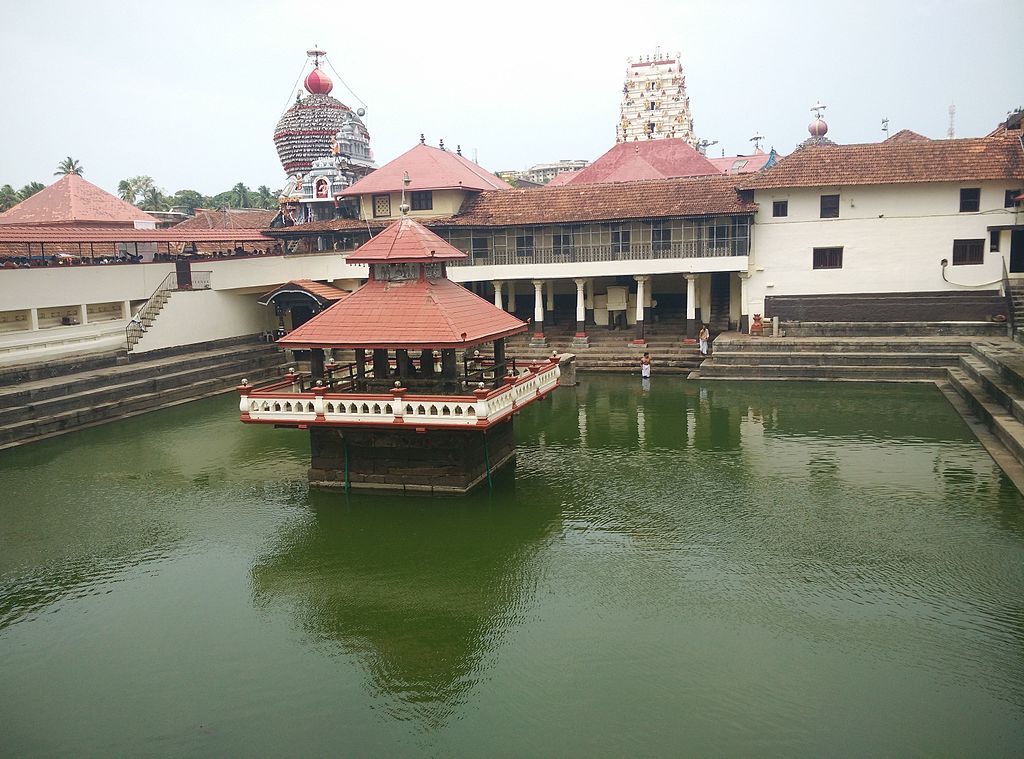
This deity of Bala-Krishna is believed to date back to Dvapara Yuga and was personally installed by Lord Krishna during His manifested pastimes in Dvarka. At the end of Krishna’s pastimes, Arjuna placed the deity in Gopi-sarovara on the banks of the sea, and now it had manifested itself to Madhwacharya in the age of Kali. When thirty strong-built men failed to lift the deity, Madhwacharya effortlessly picked it up and took it to his ashrama in Udupi, where he bathed and installed it. Madhwacharya awarded Sannyasa to some of his disciples and entrusted them with the service of Lord Bala-Krishna.
Thousands of devotees flock to the Krishna temple in Udupi throughout the year to catch a glimpse of Lord Krishna. The unique feature of the Sri Krishna Temple in Udupi is that the Lord is worshiped only through a window with nine holes called the Navagraha Kitiki, which is exquisitely carved and silver-plated. It has been a tradition in this temple to worship the Lord only through this window. Surrounding the Sri Krishna Matha are several temples, including the Udupi Anantheshwara Temple, which is over a thousand years old.
#13 Arulmigu Rajagopalaswamy Temple, Tiruvarur, Tamil Nadu
The Rajagopalaswamy temple, situated in India, is a significant Vaishnavite shrine dedicated to Rajagopalaswamy, a form of Lord Krishna. Spanning over an extensive area of 23 acres (93,000 m2), this temple is regarded as the ‘Dakshina Dwarka’ by Hindu pilgrims. It is renowned for its grandeur and is home to 16 towering gateways or gopurams, seven outer courtyards or prakarams, 24 shrines, seven halls or mandapams, and nine sacred temple tanks or theerthams. For history enthusiasts, this temple is a must-visit destination.
The temple’s presiding deity, Rajagopalaswamy, is also known as Rajamannar and is a colossal deity. The temple was originally built during the 10th century by Kulothunga Chola I and was later expanded by Rajaraja Chola III, Rajendra Chola III, and the Thanjavur Nayaks during the 16th century.
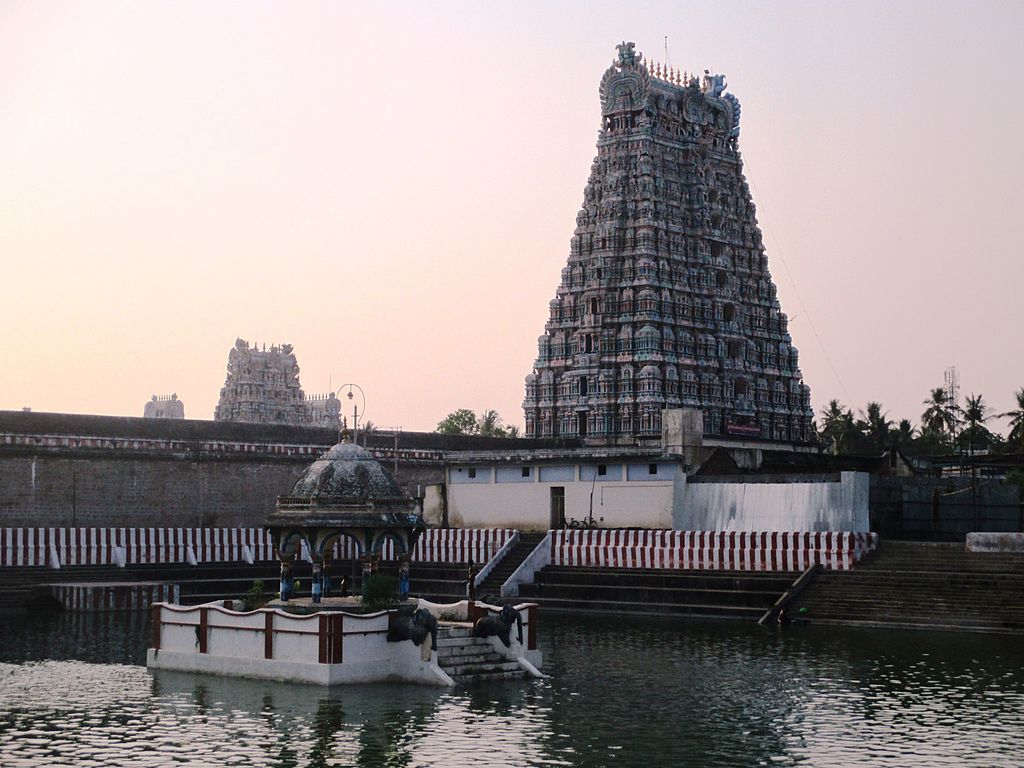
Apart from the main hall, the temple also boasts nine water bodies, with Haridra Nadhi being one of the largest temple tanks in India. The temple is particularly crowded during its three annual festivals, with the chariot festival celebrated during the Tamil month of Panguni (June-July) being the most prominent. The temple is administered and maintained by the Hindu Religious and Endowment Board of the Government of Tamil Nadu. Overall, the Rajagopalaswamy temple is a remarkable testament to the rich cultural heritage of India and a popular destination for both locals and tourists alike.
#14 Ambalapuzha Sree Krishna Temple, Ambalapuzha, Kerala
Ambalapuzha Sree Krishna Temple in Alappuzha district, Kerala, is a famous Vaishnava temple dedicated to Lord Krishna. It was built during the 15th century by Chembakasserry Pooradam Thirunal Devanarayanan Thampuran. The temple is known for its Kerala-style architecture, Chuttambalam, and beautiful wall paintings of the Dasavatharam. The temple also has a large pond for devotees to wash their feet and is famous for the performance of Pallipana by Velans every twelve years. The Ottanthullal, a satirical art form, was first performed here. During Tipu Sultan’s raids in 1789, the idol of Sri Krishna from the Guruvayoor Temple was kept here for three years. The main offering of the temple is Ambalappuzha Palpayasam, a sweet milk porridge.
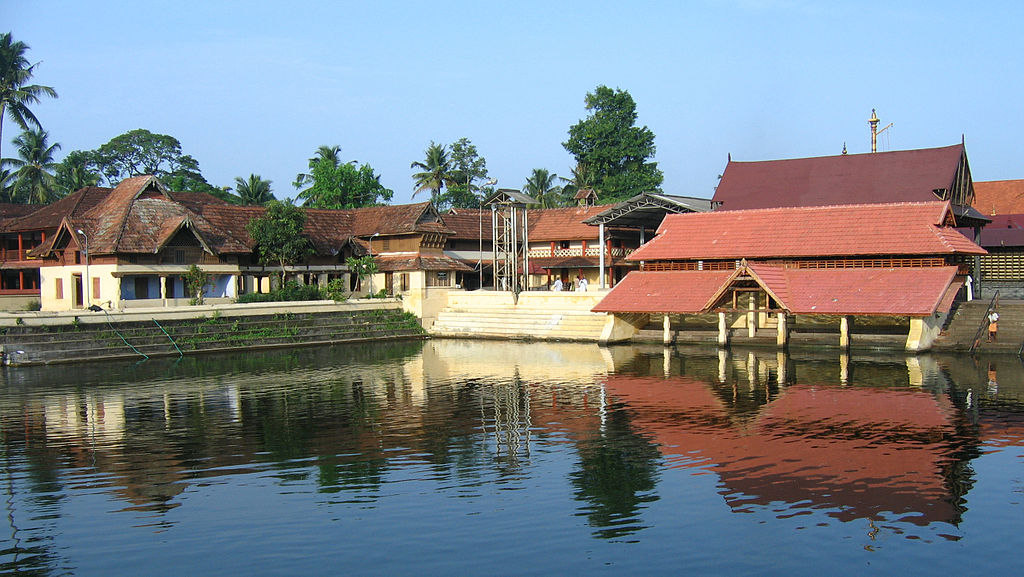
Legend has it that Lord Krishna once appeared as a sage and challenged the King, who was a chess enthusiast, for a game. The sage asked for a few grains of rice as a prize, with the amount to be determined using a chess-board, starting with one grain and doubling with each square. The king lost, and the amount of rice required was so large that the king could never pay it. The sage appeared in his true form and allowed the king to pay him over time by serving pudding made of rice in the temple daily until the debt was paid.
#15 Guruvayur Temple, Guruvayur, Kerala
In the Indian state of Kerala lies the town of Guruvayur, where the revered Guruvayur Temple is situated. This Hindu temple is dedicated to Guruvayurappan, an incarnation of Lord Krishna, and holds great significance for Hindus not just in Kerala, but also in Tamil Nadu. Known as Bhuloka Vaikunta, or Vaikuntha on earth, this temple is home to a central four-armed standing idol of Vishnu, holding a conch (Panchajanya), discus (Sudarshana), mace (Kaumodaki), and a lotus with a tulasi garland. This particular form of Vishnu was revealed to Vasudeva and Devaki, Lord Krishna’s parents, during his birth. Notably, the idol of Lord Unnikrishnan Guruvayur is made of a rare mixture called Padala Anjanam, which is distinct from the commonly used stone or metal materials.

The central shrine of the temple is said to have been reconstructed in the year 1638 C.E. The architecture and individual elements found within the shrine are stunning representations of the site’s history. As per tradition, the shrine is oriented towards the East and features two Gopurams, or towers – one in the East (Kizhakkenada) and the other in the West (Padinjarenada). The pillars of light, known as Deepastambam, can be found in front of and on the east side of the Nalambalam, which is a square-shaped column. Numerous light pillars are present in the temple, with the eastern Deepastambam measuring 24 feet in height and featuring thirteen circular receptacles, creating a breathtaking sight when illuminated. Another famous attraction here is the Dwajasthamba – a 70-foot-tall flagstaff fully covered in gold. Despite its simple construction, the temple’s spiritual ambiance is unmatched, drawing in devotees from various parts of the country.
Image Credits
Vinayaraj, CC BY-SA 4.0, via Wikimedia Commons
Shravan Kamath94, CC BY-SA 4.0 , via Wikimedia Commons
Ssriram mt, CC BY-SA 4.0, via Wikimedia Commons
Vinayaraj, CC BY-SA 3.0, via Wikimedia Commons
RanjithSiji, CC BY 3.0, via Wikimedia Commons